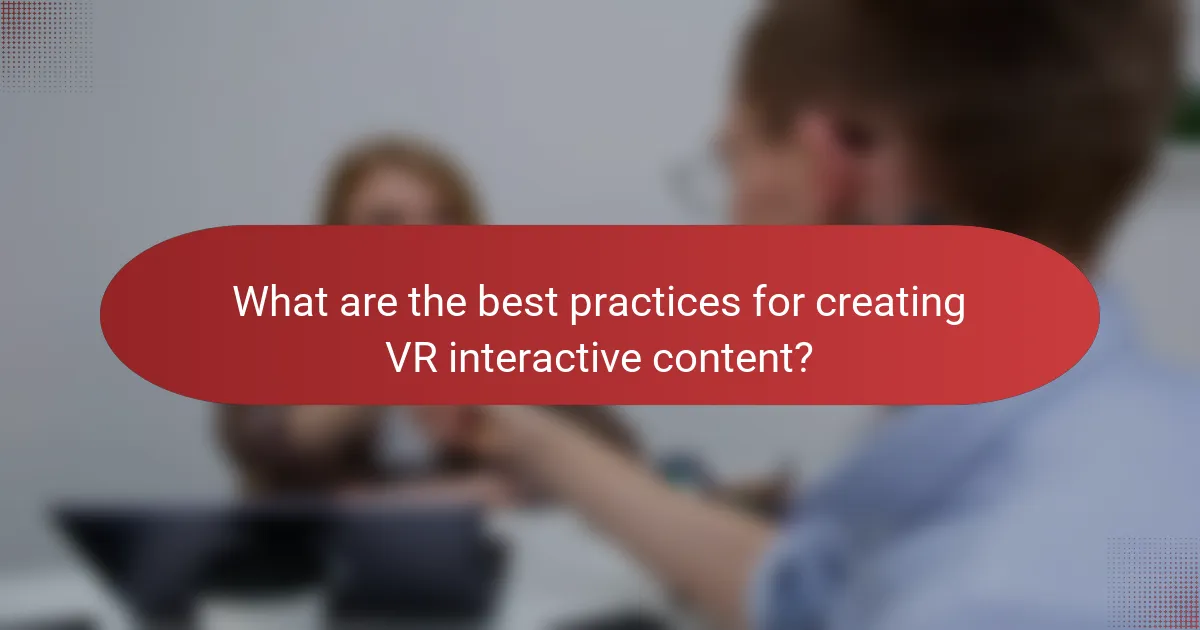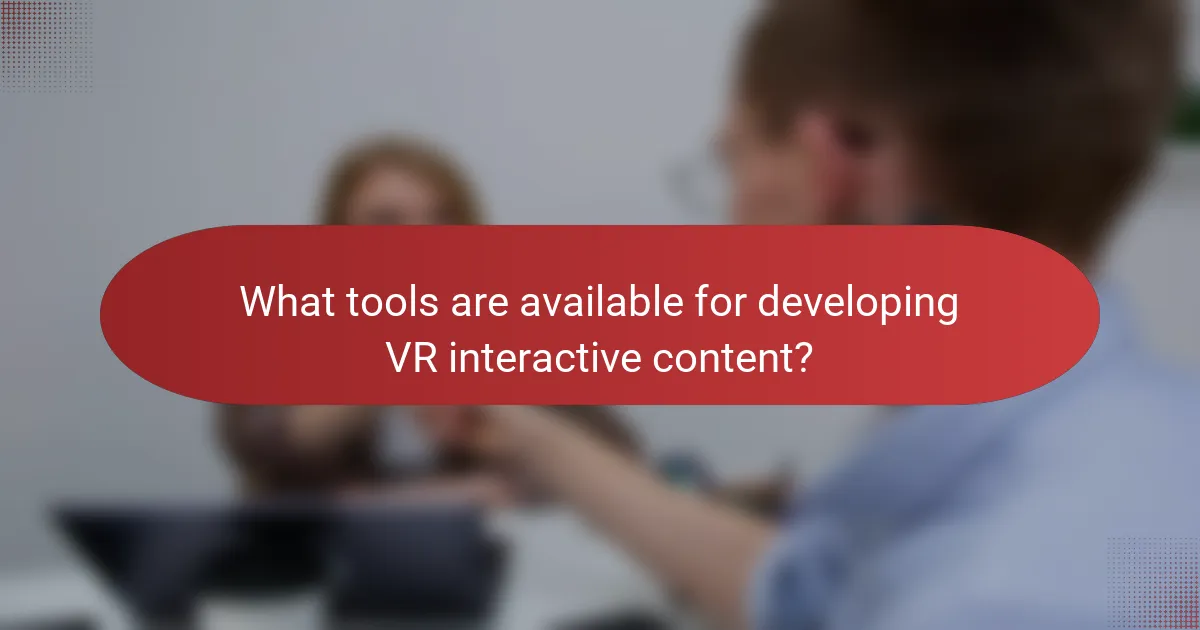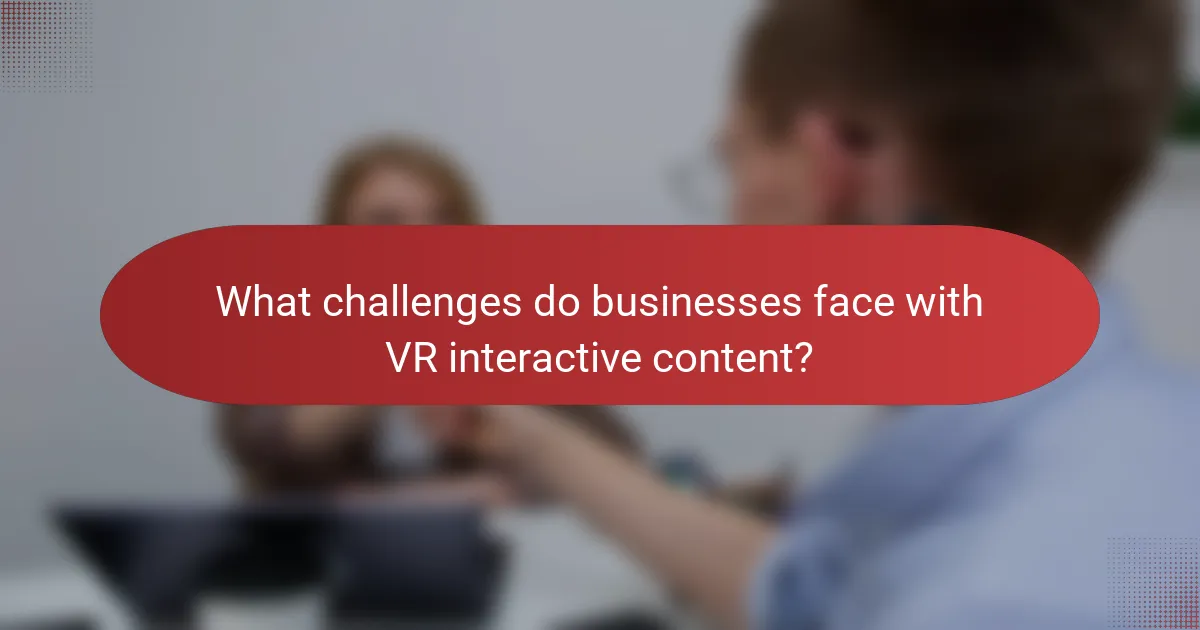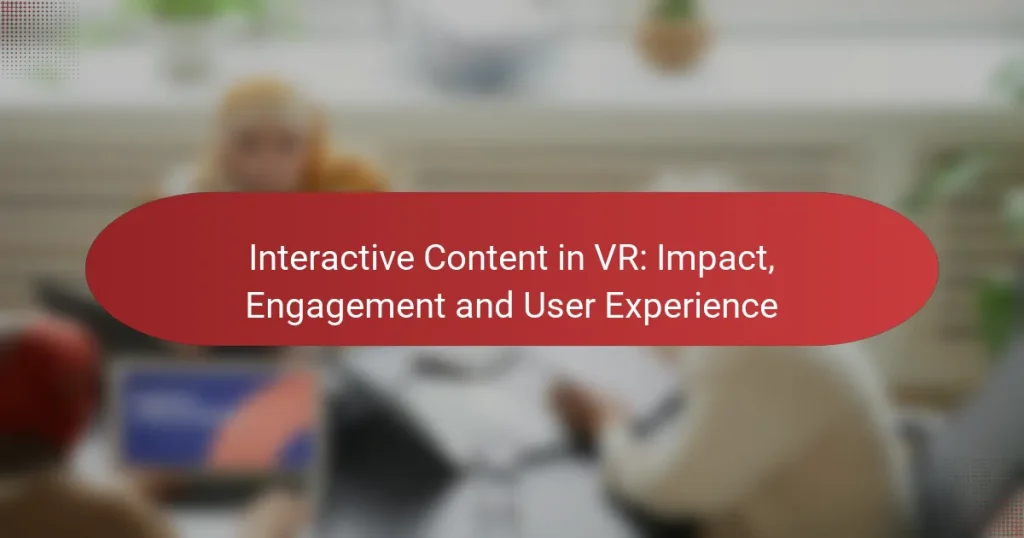Interactive content in virtual reality (VR) revolutionizes user engagement by providing immersive experiences that draw users in and foster emotional connections. By prioritizing user-centered design and compelling storytelling, creators can craft memorable interactions that enhance how users engage with content across various platforms. With tools like Unity 3D, Unreal Engine, and Blender, developers can bring these innovative experiences to life, catering to diverse skill levels and project needs.

How does interactive content in VR impact user engagement?
Interactive content in virtual reality (VR) significantly enhances user engagement by creating immersive experiences that captivate users’ attention. This engagement leads to deeper emotional connections and a more memorable experience, which can transform how users interact with content across various platforms.
Enhanced immersion
Enhanced immersion in VR allows users to feel as though they are part of the environment, rather than just observers. This is achieved through realistic graphics, spatial audio, and interactive elements that respond to user actions. For instance, in a VR training simulation, users can practice skills in a lifelike setting, making the experience more engaging.
To maximize immersion, developers should focus on high-quality visuals and intuitive controls. Avoiding motion sickness is crucial, so ensuring smooth transitions and maintaining frame rates above 60 frames per second can help keep users engaged without discomfort.
Increased retention rates
Interactive VR content often leads to increased retention rates, as users are more likely to remember information presented in an engaging format. Studies suggest that people retain information better when they actively participate in learning rather than passively consuming it. For example, educational VR experiences can improve knowledge retention by allowing users to explore concepts interactively.
To boost retention, consider incorporating storytelling elements that resonate with users. Using familiar scenarios or relatable characters can make the content more memorable and encourage users to revisit the experience.
Real-time feedback
Real-time feedback in VR enhances user engagement by providing immediate responses to actions, which helps users understand the consequences of their decisions. This interactivity can be particularly effective in training and educational contexts, where users can learn from their mistakes in a safe environment. For example, a VR simulation for medical training can offer instant feedback on a procedure, allowing learners to adjust their techniques on the spot.
When designing for real-time feedback, ensure that the responses are clear and informative. Avoid overwhelming users with too much information at once; instead, provide concise, actionable insights that guide their learning process effectively.

What are the best practices for creating VR interactive content?
Creating effective VR interactive content requires a focus on user engagement, intuitive design, and immersive experiences. Best practices include prioritizing user-centered design, integrating compelling storytelling, and ensuring accessibility for all users.
User-centered design
User-centered design is crucial for VR interactive content as it places the user at the forefront of the development process. This approach involves understanding user needs, preferences, and behaviors to create intuitive interfaces and interactions.
To implement user-centered design, conduct user research through surveys, interviews, and usability testing. Iteratively refine your content based on feedback to enhance the overall experience. Aim for a seamless interaction flow that minimizes cognitive load and maximizes engagement.
Storytelling integration
Integrating storytelling into VR content enhances user immersion and emotional connection. A strong narrative can guide users through experiences, making them feel like active participants rather than passive observers.
To effectively weave storytelling into your VR content, create relatable characters and scenarios that resonate with your audience. Use environmental cues and interactive elements to advance the plot and encourage exploration. Consider employing branching narratives that allow users to make choices, leading to different outcomes.
Accessibility considerations
Accessibility is essential in VR interactive content to ensure that all users, including those with disabilities, can fully engage with the experience. This includes accommodating various physical, sensory, and cognitive needs.
Implement features such as adjustable control schemes, audio descriptions, and visual aids to support diverse user requirements. Regularly test your content with users who have disabilities to identify barriers and improve inclusivity. Adhering to established accessibility guidelines, such as the Web Content Accessibility Guidelines (WCAG), can also enhance your content’s usability.

What tools are available for developing VR interactive content?
Several tools are available for developing VR interactive content, each offering unique features and capabilities. Popular options include Unity 3D, Unreal Engine, and Blender, which cater to different skill levels and project requirements.
Unity 3D
Unity 3D is a widely-used game engine that supports VR development with a user-friendly interface and extensive asset store. It allows developers to create immersive experiences using C# scripting and offers a range of plugins for VR hardware compatibility.
When using Unity, consider its cross-platform capabilities, enabling deployment across various VR headsets like Oculus Rift and HTC Vive. Beginners can benefit from numerous tutorials and community support, while advanced users can leverage its powerful features for complex projects.
Unreal Engine
Unreal Engine is known for its high-fidelity graphics and robust performance, making it ideal for creating visually stunning VR content. It utilizes Blueprints, a visual scripting language, which allows developers to create interactive experiences without extensive coding knowledge.
Unreal Engine is particularly suited for projects requiring realistic environments and detailed animations. Its built-in VR template can help streamline the development process, but it may have a steeper learning curve for newcomers compared to Unity.
Blender
Blender is an open-source 3D modeling tool that can be used for creating assets for VR applications. While it is not a game engine, it excels in modeling, texturing, and animating, making it a valuable resource for asset creation in VR projects.
When using Blender, focus on exporting models in compatible formats for Unity or Unreal Engine. Its extensive community and resources can help users learn the intricacies of 3D design, but be prepared for a learning curve if you are new to 3D modeling.

What are the key metrics for measuring VR content effectiveness?
The key metrics for measuring VR content effectiveness include user engagement levels, completion rates, and feedback scores. These metrics provide insights into how well the content resonates with users and its overall impact on their experience.
User engagement levels
User engagement levels indicate how actively participants interact with VR content. High engagement often reflects a compelling experience that captures attention, while low engagement may signal a need for improvement. Metrics such as session duration, interaction frequency, and user retention can help gauge engagement.
For example, tracking how long users remain immersed in a VR environment can reveal whether the content holds their interest. Aim for engagement times that exceed several minutes, as this typically suggests a more captivating experience.
Completion rates
Completion rates measure the percentage of users who finish a VR experience compared to those who start it. A high completion rate indicates that the content is engaging and user-friendly, while a low rate may suggest obstacles or lack of interest. Aim for completion rates above 70% for effective content.
To improve completion rates, consider simplifying navigation and ensuring that the experience is intuitive. Regularly testing the content with real users can help identify pain points that may hinder completion.
Feedback scores
Feedback scores provide qualitative insights into user satisfaction and the perceived value of the VR experience. Collecting feedback through surveys or rating systems can help identify strengths and areas for improvement. Scores typically range from 1 to 5, with higher scores indicating better user experiences.
Encourage users to provide specific comments alongside their scores to gain deeper insights. This feedback can guide future content development and help refine existing experiences to better meet user expectations.

What challenges do businesses face with VR interactive content?
Businesses encounter several challenges when creating VR interactive content, including high development costs, technical limitations, and user adoption barriers. These factors can significantly impact the feasibility and success of VR projects.
High development costs
The creation of VR interactive content often requires substantial financial investment. Costs can range from tens of thousands to millions of dollars, depending on the complexity of the project and the technology used.
Businesses should consider budgeting for not only the initial development but also ongoing maintenance and updates. Collaborating with experienced developers can help mitigate costs and improve project outcomes.
Technical limitations
Technical limitations in VR hardware and software can hinder the development of interactive content. Issues such as limited processing power, inadequate graphics capabilities, and compatibility across devices can affect user experience.
To address these challenges, businesses should stay informed about the latest advancements in VR technology and consider using established platforms that offer robust support and resources for developers.
User adoption barriers
User adoption of VR interactive content can be slow due to various barriers, including the need for specialized hardware and a lack of familiarity with the technology. Many potential users may not own VR headsets or may be hesitant to engage with new platforms.
To encourage adoption, businesses should focus on creating accessible and user-friendly experiences. Offering demos or trials can help potential users understand the value of VR content and increase engagement.

How can businesses leverage VR for lead generation?
Businesses can utilize virtual reality (VR) to enhance lead generation by creating immersive experiences that engage potential customers. By offering interactive content, companies can capture attention, provide unique product demonstrations, and gather valuable data on user preferences.
Creating Immersive Experiences
Immersive experiences in VR allow businesses to showcase their products or services in a compelling way. For example, a real estate company can offer virtual tours of properties, enabling potential buyers to explore homes from anywhere. This not only saves time but also increases interest and engagement.
To create effective immersive content, focus on high-quality visuals and intuitive navigation. Ensure that the experience is user-friendly and provides clear calls to action, encouraging users to take the next step, whether that’s signing up for more information or making a purchase.
Data Collection and Analysis
VR can serve as a powerful tool for collecting user data during interactions. By tracking user behavior, businesses can gain insights into preferences and pain points, which can inform marketing strategies. For instance, analyzing which features users engage with most can help tailor future content and offerings.
Implementing analytics tools within the VR experience is crucial. Ensure that you comply with data protection regulations, such as GDPR in Europe, when collecting and processing user information.
Cost Considerations
Investing in VR technology can be significant, but the potential return on investment (ROI) can justify the costs. Initial expenses may include VR hardware, software development, and content creation. However, as VR technology becomes more accessible, costs are expected to decrease.
Consider starting with smaller projects or pilot programs to test the waters. This approach allows businesses to gauge effectiveness and make adjustments before committing to larger-scale implementations.
Common Pitfalls to Avoid
When leveraging VR for lead generation, businesses should avoid common pitfalls such as overcomplicating the user experience or neglecting mobile compatibility. Ensure that the VR content is engaging but not overwhelming, as this can lead to user frustration and disengagement.
Additionally, failing to promote the VR experience can limit its reach. Use various marketing channels to inform potential customers about the availability of VR content, ensuring they understand how to access and benefit from it.

